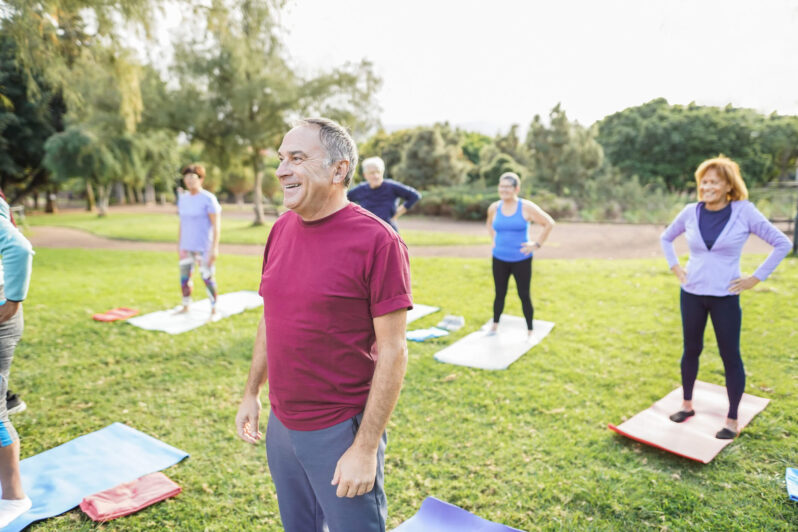
No older adult wants to suffer a fall, especially considering how serious the consequences can be. Improving balance and building strength can help reduce the likelihood a fall will occur, and also provide other health benefits as well. That’s why exercises to prevent falls should be a part of every senior’s fitness regimen.
At St. Mark Village, we pay special attention to helping residents maintain and build their strength, as well as work on their balance. We’ve put together some activities and exercises to prevent falls (and some are actually fun!) Here are a few.
Exercises to Prevent Falls
Always remember to take your time, do what feels comfortable, and breathe deeply. Here are just a few suggested exercises to prevent falls.
Chair sit to stand
- Sit in a sturdy chair with arms.
- Use both legs and arms, pushing down on armrests, to stand up.
- Pause, then repeat.
- Try 10 repetitions. If it becomes too easy, use only one hand.
- Next level: standing with arms crossed in front of chest.
Side leg raise
- Hold on to chair or kitchen counter.
- Stand straight, raise leg straight out behind, keeping it straight.
- Repeat 10 times on each side, raising leg slowly (use muscles, not momentum), without leaning forward or rocking.
Balance on one leg
- Position yourself between two chairs of same height, or use countertop.
- Hold on to the chairs or the counter and raise one foot, balancing on the other.
- Hold for 15 seconds.
- Repeat, raising other leg.
As you grow stronger, try holding on with one hand. Eventually try doing this exercise without holding on to anything (but be near a sturdy surface for safety).
Download our free guide, Just The Facts: Your Guide to Independent Living.
Activities to Prevent Falls
Tai Chi
The National Council on Aging reports that many studies have shown Tai Chi to be one of the most effective exercises to prevent falls. Tai Chi targets leg strength, flexibility, range of motion, and reflexes.
One specific form, Tai Chi for Arthritis and Falls Prevention, helps people with arthritis to improve all muscular strength, flexibility, balance, stamina, and more. Developed by Dr. Paul Lam and medical colleagues, this program utilizes the easy-to-learn Sun style Tai Chi for its ability to improve relaxation and balance. Movements involve both left and right sides, with turns to move forward and backward, to improve mobility.
Walking
When you think about exercises to prevent falls, you might not think of walking, but it actually can be quite effective in building balance. According to Harvard Health, walking, as well as biking and climbing stairs, helps you strengthen the muscles in the lower body. It also is a great way to stretch muscles and thus improve your posture, which in turn, can improve your balance.
Be sure to walk with a purpose. Focus on what you are doing, wearing comfortable clothing and shoes that are made for walking. Whether indoors on a track, or outdoors on a walking path, think about your steps, keep your head high, and walk confidently. Hold yourself upright and breathe deeply.
Remember to enjoy the moment: it can feel great to breathe fresh air!
Yoga
Yoga is good for so many things that affect healthy aging. Reducing stress. Treating fatigue. Lessening pain. And perhaps most importantly, increasing core strength and balance, which in turn, can reduce the risk of falling. And the great news: you can do it sitting in a chair, standing, or on a mat.
The goal in gentle yoga is to keep the moves gentle, restorative, and soothing.
Here are a few simple poses:
- Mountain pose
It seems too simple to do anything for you. Yet, the mountain pose can help improve posture, calm your focus, and improve balance.
Stand upright with feet facing forward, arms at your sides, palms facing forward. Use this pose to feel where your weight is balanced on your feet. By elongating the spine, you create more control and improve posture. Closing your eyes can help you to derive more benefits from this pose.
- Tree pose
This pose helps improve balance, while stretching your thighs, groin, torso and shoulders. And while for many, a tree pose means raising one leg so that you can place your foot as high as possible on your leg, the following is a gentler form of this pose which offers you the same benefits without as much work:
-
- Stand with your legs together. Keep your arms straight over your head; palms together.
- Raise your right leg slightly off the ground, making sure your toes still touch the ground and your heel is touching the inside of your left ankle. (If you need to, hold onto something to maintain balance.)
- Hold the post for 20 to 30 seconds, if possible.
- Switch to your other leg.
- As your balance improves, try gradually drawing your raised foot higher, resting it on the inside of your shin.
Balance is just one aspect of healthy aging
At St. Mark Village, balance is a big part of our Wellness Matters program, which also includes trivia, CrossFit, yoga, Tai Chi, shuffleboard, meditation, line dancing, walker line dancing, brainiacs, sittercize, chair volleyball, a birdwatching group, and fitness groups for men and women.
Before taking their first balance class, residents of St. Mark Village are assessed to determine where they fit within their age range. Following the assessment, residents are introduced to classes utilizing the Biodex Balance System™ SD, a specialized device designed to improve balance, increase agility, and develop muscle tone.
We’d love to tell you more about how our community is focused on your wellbeing. Aging well starts here!
A focus on total wellness with seamless access to future care options. Download our free guide, Just The Facts: Your Guide to Independent Living. Or contact us. We’d love to hear from you.



















